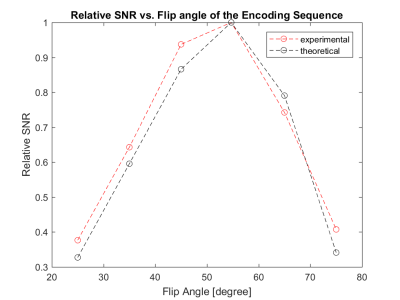2671
Exploring the Limits of Super-Resolution MRI with Phaseless Encoding1Institute for Biomedical Engineering, University of Zurich and ETH Zurich, Zurich, Switzerland
Synopsis
The recently proposed method of Super-resolution (SR) MRI with phaseless subpixel encoding simultaneously samples three neighboring k-space bands and provides resolution enhancement factor up to 3.0. We now demonstrate an almost five-fold resolution enhancement by applying additional encoding steps of
Introduction
As an analogue with the optical method of structured illumination [1][2], sinusoidal microscopic tagging in MRI provides subpixel resolution by mixing neighboring spatial frequency (k-space) bands in the central acquisition window [3][4]. This acquisition scheme can be seen as a combination of standard Fourier encoding with a phaseless encoding basis. By resolving the three superimposed adjacent bands based on at least three low-resolution magnitude images with different tag shifts, spatial resolution can be enhanced up to three times without the sensitivity to motion-related phase fluctuation, which plagues conventional multi-shot scanning schemes.
If more neighboring k-space bands could be mixed and then resolved, a further enhancement of spatial resolution is expected. However, lower signal to noise ratio (SNR) might degrade image quality when spatial resolution increases. Therefore, the goal of this study is to explore the limits of the Super-resolution(SR) MRI with phaseless encoding, including further resolution enhancement by acquiring five bands in k-space, optimization of flip angle with respect to SNR and correction of artefacts caused by flip angle deviation from the nominal value based on a B1 map.
Methods
Phaseless encoding was applied twice with different tagging wavelengths to provide subpixel information at different scales in low-resolution spin-echo scans. The tagging period in the first acquisition was 1.25 times the low-resolution pixel size and half this value in the second acquisition. In k-space perspective, this causes mixing of the central band with two neighboring sidebands (with 20% overlapping) in the first scan, and two bands at twice this distance in the second (Fig.1). In both cases, the three bands were resolved based on three tag shifts, as in the standard phaseless encoded reconstruction[4]. The three resolved bands in each of these separate acquisitions were finally interleaved in k-space to produce the SR image with 5 neighboring bands in total.
The SNR of phaseless encoding was further examined by quantifying the noise propagation through the reconstruction matrix as a function of the tagging flip angle, with the presumption that the signal itself is always fully recovered as long as the tagging flip angle is not much larger than 45°. A series of measurements were conducted to verify the result of the calculation.
A location-dependent B1 inhomogeneity correction method based on a measured B1 map was tested in MATLAB simulation based on a Shepp-Logan phantom. In the mechanism, this correction method shares large similarity with the correction method for location-dependent B0 offset in phaseless encoding[5]. All phantom experiments were carried out on a 3 Tesla MRI system (Achieva 3T, Philips Healthcare, The Netherlands) and a single receiver coil using an own modification of the manufacturer’s sequence code.
Results
The SR image with very close to 5-fold resolution was successfully reconstructed by 2 separate acquisitions of phaseless encoding with different tagging wavelengths (Fig.2). The very fine details, which is still undistinguishable in the 3-fold reconstruction, became resolved in the 5-fold resolution image.
The optimal flip angle of the tagging with respect to SNR turns out to be the solution of the equation $$$3\cos^2{\theta}-1=0$$$, i.e. the magic angle ($$$\approx54.7°$$$). With such optimal flip angle of tagging, the three mixed k-space bands share the same modulated amplitude which minimizes the total noise amplified by the reconstruction matrix. The SNR dependency with respect to the flip angle of the encoding sequence in phaseless encoding was verified by a series of measurements (Fig.3).
The simulated B1 map corresponded to tagging flip angle smoothly varying between 45 and 60 degrees within the phantom. The image reconstructed using the nominal value of 45 degrees contains artefacts and reduced intensity in the region of strong flip angle deviation. These artefacts can be removed when the field map is used to correct the effective signal contribution from the three k-space bands (Fig.4).
Discussions/Conclusions
Spatial resolution can be enhanced beyond the SR factor of 3.0 attained so far by separate acquisitions of the same phaseless encoding scheme with different tagging periods. This is similar to the saturated structured illumination in optics[2], however with higher order harmonics acquired separately rather than simultaneously. The SNR of phaseless encoding can be maximized without noticeable adverse effects with flip angle of the tagging slightly above 45 degrees. Artefacts caused by B1 inhomogeneity can be corrected location dependently, which should be advantageous at high magnetic fields.Acknowledgements
No acknowledgement found.References
[1] Frohn J., Knapp H. and Stemmer A. (2000). True optical resolution beyond the Rayleigh limit achieved by standing wave illumination. Proceedings of the National Academy of Sciences, 97(13), pp.7232-7236.
[2] Gustafsson M. (2005). Nonlinear structured-illumination microscopy: Wide-field fluorescence imaging with theoretically unlimited resolution. Proceedings of the National Academy of Sciences, 102(37), pp.13081-13086.
[3] Ropele S., Ebner F., Fazekas F. and Reishofer G. (2010). Super-resolution MRI using microscopic spatial modulation of magnetization. Magnetic Resonance in Medicine, 64(6), pp.1671-1675.
[4] Hennel F. and Pruessmann K. (2016). MRI with phaseless encoding. Magnetic Resonance in Medicine, 78(3), pp.1029-1037.
[5] Hennel F., Tian R., Engel M and Pruessmann K. (2018). ISMRM&ESMRMB, submitted.
Figures
